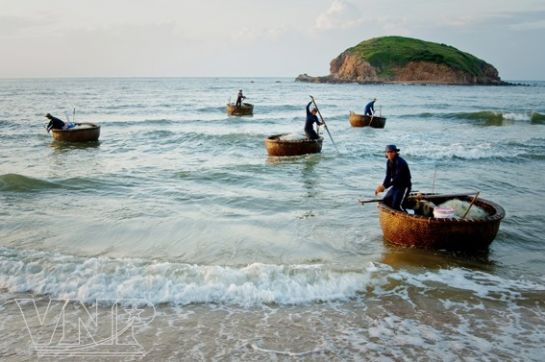Before the
construction can begin the craftsmen must cut the selected bamboo to size
and treat its outer skin, enabling it to absorb otter fat that will be
applied later to prevent the coracle from leaking. The bamboo is then
split into straps that are dried under the hot sun and then exposed to the
dew over two nights to flatten. It is essential to keep the straps from
getting wet with rain-water to prevent cracking. During the rainy season
the drying process takes place in the house. Once the straps are dried the
coracle construction begins. This takes place at the mould that is set up
in the craftsmen’s garden.
Depending on where they live along the coast and the
type of fishing they are involved in, the fishermen use the coracle in
different ways. On Ly Son Island in
Quang
Ngai
Province the coracle is used to
catch cuttlefish. On a normal fishing day a large boat will carry 8 to 10
coracles out to sea and throw them overboard at a predetermined spot
thought to be rich with cuttlefish. With one fisherman per coracle, the
crafts head out in a straight line, each staying in a prescribed area to
prevent overlapping. The fishermen will either dive for the fish or catch
them in nets.
Meanwhile,
fishermen in the
provinces
Binh Thuan and Ninh Thuan, or in Long Hai District in the Southern
only use the coracles for their offshore fishing, but also for inshore
fishing, such as diving for oysters and fishing with
nets.
The coracle is
also used as a “mobile shop” to supply food and other necessities to
fishermen anchored offshore, or for buyers to paddle out to anchored boats
that have returned from fishing trips to purchase sea catch.
Last but
not least, the coracles are used by participants at race competitions held
by the fishing villages during their traditional festivals.
Story: Huu Thanh
Photos: Kim Son –
Minh Quoc – Huu Thanh














